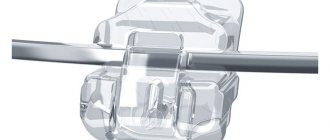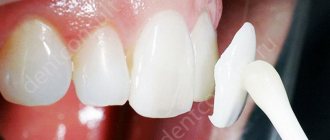Technology such as veneers has existed for decades. But many patients still have questions: how convenient, practical, and most importantly, how safe is it for dental health? After all, the enamel has to be ground down before the procedure, and the plates are installed once for many years. Is it possible that caries will develop under the veneers over the years? Today we destroy these myths.
Veneers are selected according to shade, size and thickness so that the smile looks natural and beautiful.
Porcelain veneers
Porcelain plates are visually indistinguishable from the enamel of a normal tooth. Therefore, ordinary people will never guess about the installed records.
The advantages of ceramic crowns are that they are resistant to stress and practically do not stain.
Porcelain microprostheses are made using two methods:
1. Pressed ceramics - the material is applied in layers, then each layer is fired. In this case, the teeth are not ground down.
2. Pressed material – ceramic material is pressed under pressure and then fired at high temperatures. This method is used to achieve the strongest possible structure.
How to make porcelain veneers is decided by the doctor, based on the individual characteristics of the patient.
Plus, the service life of ceramic restorations is more than 20 years. If you decide to put veneers or crowns on your teeth, follow hygiene procedures.
Examples of dental restoration in stars
Dental restoration using veneers is now considered common among show business stars. The result really transforms the face, here are some examples:
Photo: Cheryl Cole
Photo: Miley Cyrus
Victoria Beckham
Scarlett Johansson
If you find an error, please select a piece of text and press Ctrl+Enter.
Tags veneers photos
Did you like the article? stay tuned
Previous article
Kamistad gel - instructions for use of the drug
Next article
Description of the structure of the human tooth
E-max ceramic veneers and zirconium dioxide
Metal-free veneers contain a frame made of lithium disilicate or zirconium dioxide. Such plates are almost transparent and have a fine structure. And unlike others, their service life increases to 25–30 years.
Pros of ceramic zirconium veneers
• Duration of operation is longer than that of porcelain;
• Lithium disilicate plates look natural, regardless of lighting;
• Color does not change after eating food coloring;
• Do not accumulate plaque if the rules of oral hygiene are ignored;
• Does not have a black coating when smoking;
• They are light in weight and thin, so wear off of the enamel is minimal.
Zirconium veneers, unlike composite plates, are placed on teeth, even in the most difficult clinical cases. Usually, they are inserted in the smile zone - on the 10 upper and 8 lower teeth.
The downside is that the insertion process takes longer due to the fact that the material is difficult to fix on the tooth surface.
Installation requires minor tooth grinding.
Braces or veneers - what to choose?
You can straighten your teeth with braces and veneers. However, it is impossible to compare systems, since the former correct malocclusions by moving teeth to the correct position, while the latter only mask aesthetic defects and correct the shape.
For minor crooked teeth, a specialist will most likely recommend the installation of veneers, and in the case of more serious pathologies, correction with braces.
| Braces | Veneers |
✔ Corrects dental abnormalities for life ✔ Needs careful care ✔ Have an adaptation period |
✔ Defects are corrected in one or two procedures ✔ Installed for a period of no more than 10 years ✔ There are no special indications for hygiene ✔ Doesn’t require a lot of getting used to |
In terms of price, the braces system is more profitable than prosthetics with veneers. The cost of installing orthodontic devices in Moscow clinics starts from 65,000 rubles. A ceramic onlay for one tooth costs from 34,000 rubles, and in most cases a minimum of four microprostheses are required. The most affordable are composite veneers (from 3,000 to 8,000 rubles), but these structures cannot be called durable.
Composite veneers (componeers)
They are made from filling material in two ways and differ in how veneers are placed on the teeth:
1. Aesthetic filling (therapeutic) - installation occurs in one stage. Specialist. Using equipment, the doctor polishes the front side of the tooth. Then filling material is applied to this plane. Apply as thin a layer as possible. This method can hide only minor aesthetic problems.
2. Production of composite plates in a dental laboratory using special impressions. Before installing veneers on the front teeth, the dentist grinds down the enamel. The process requires several steps, so the implants are fixed at subsequent appointments.
The downside is that the service life of composite veneers is 5 years. A significant disadvantage is also a change in the color of the plates - darkening of the cladding.
Life time
How long you can use veneers depends on the material. Composite veneers are short-lived and will have to be replaced after a maximum of 5 years. In addition, they can crack and change color.
Linings made from new materials last much longer. Veneers made from E-max, Ceramage, Zirkonzahn materials last 15-20 years.
But not only the material affects the service life. The skill of the doctor is also important here. Therefore, it is worth contacting clinics where dentists have experience in installing veneers from different materials and for different indications.
Indications for installation of veneers
1. People who were unable to achieve the desired teeth color.
2. Darkening of the tooth enamel occurred due to a filling made with formaldehyde paste, or when a nerve was removed.
3. Old fillings that have changed their color and differ from tooth enamel.
4. They are given to people who have diastemas, trema, and chips.
5. When the teeth have an irregular anatomical shape (wedge-shaped).
6. The patient has diseases - this could be enamel erosion, necrosis, hypoplasia, etc.
Who are veneers contraindicated for?
People who have the following diseases and problems are not recommended to get implants.
• The presence of a dental anomaly “bruxism” is a forceful clenching of the jaws during sleep.
• Insufficient amount of tooth enamel.
• Bite pathology, meaning straight, deep bite.
• Caries and its complications.
• A group of diseases that are characterized by inflammatory processes - gingivitis, periodontal disease, etc. These diseases are a temporary contraindication. After treatment, the structures are successfully installed.
• Severe tooth fragility, or the presence of a bulky filling.
Veneers and Lumineers, and how they differ
Lumineers are crowns made from special dental porcelain.
Lumineers are produced by the American company, which has developed and patented the specific composition of dental porcelain and production technology. This company produces lumineers in California. Therefore, the production of such micro prostheses takes about 30 days.
The word lumineers comes from the Latin word “lumen”, which literally means “light”. The creators of lumineers claim that your teeth will become much whiter. This means that the client will receive a “Hollywood smile”. However, veneers are not much inferior to lumineers. The latter can be distinguished rather by their “luminous effect”, but otherwise they are simply an analogue of ceramic veneers.
A significant advantage of lumineers is the thickness of the plate. It is: 0.2 - 0.3 mm, and the thickness of the veneers: from 0.2 mm. up to 0.8 mm., therefore, lumineers are installed without preliminary turning, just like veneers. The impression is made directly from the tooth.
Preparatory process
1. Hygienic teeth cleaning, plaque removal.
2. Grind down a thin layer of enamel, from 0.5 to 0.7 mm.
3. A harmonious shade is selected.
4. The remaining enamel is coated with a special acid.
5. An impression is made.
6. The tooth plate is carefully polished and onlays are inserted.
A thin layer of enamel is ground off in order to achieve the most harmonious and natural look. They also grind it in order to insert and firmly strengthen the plate.
The process of installing permanent veneers
Permanent microprostheses are placed at the second appointment. First, the orthopedist visually assesses how suitable the finished model is:
- According to the form;
— By color;
- According to the tightness of fit to the surface of the tooth.
When the dentist is convinced that the characteristics are correct, the onlays are installed.
1. The finished structure is fitted.
2. Then they control the accuracy and tightness of the fit.
3. The procedure is completed with fixation of microprostheses.
Is it possible to get veneers without grinding teeth?
In order to avoid grinding down the enamel, veneers made from feldspar and E-max should be inserted; they are thinner and do not require such a procedure.
It is possible to refuse turning if:
1. You have uneven teeth;
2. If the teeth are heavily worn;
3. It is necessary to change the direction of a crooked tooth;
4. It is necessary to add volume to the tooth.
There are no ideal teeth, so veneers without grinding cannot yet be placed. Except if the teeth are sparse and not voluminous. Grinded teeth can no longer be restored in the future, so you will always need to install crowns or their equivalents.
What do teeth look like after and what determines their condition?
Once the veneers are removed, the teeth are left unprotected. To install the plates, part of the enamel is ground down. As a result, the tooth surface becomes porous and rough. It is more susceptible to the formation of tartar and the development of caries, since it is no longer so protected. In addition, the tooth does not look aesthetically pleasing - it has a narrow edge, small thickness, and may have unnatural points.
The patient will feel discomfort. Due to pre-grinding, sensitivity increases. Teeth react to hot, cold, and sour. Therefore, after removal, veneers will have to be placed again or another option for protecting the enamel – a crown – will have to be chosen. The dentist determines what is suitable for the patient individually. Leaving a ground tooth unprotected will be unsafe and uncomfortable.
Important!
Sometimes the condition of the teeth does not deteriorate after removal of the onlays - if the patient had lumineers installed. Such overlays do not require preliminary grinding of the enamel. After lumineers, the patient can return to their previous smile. It should be noted that such cases are rare in domestic dentistry. Lumineers are an expensive material. Patients rarely install them, and if they do, they do not remove them voluntarily.
What happens to the teeth under the structure?
When the stitching is carried out correctly, and the design of the micro prosthesis is installed correctly, then nothing happens. However, if a plate, for example a composite, is not fixed tightly, caries or plaque accumulation may appear in such areas.
In case of plate defects, it is necessary to restore the micro prosthesis.
The downside is that it is impossible to remove the veneers; only the structure is replaced.
Most dentists provide a one-year warranty after installing the onlays.
Bottom line
Veneers can make your smile aesthetically pleasing. However, to create perfect teeth you will have to say goodbye to natural beauty. Since part of the enamel must be cut down to install the onlays, veneers will have to be worn for life. This scares few people, since onlays are not installed on healthy, young and beautiful teeth. Veneers are required for patients who have defects. Before installing overlays, you need to weigh the pros and cons and think carefully about your step. This will help avoid future complications after removing the veneers.











